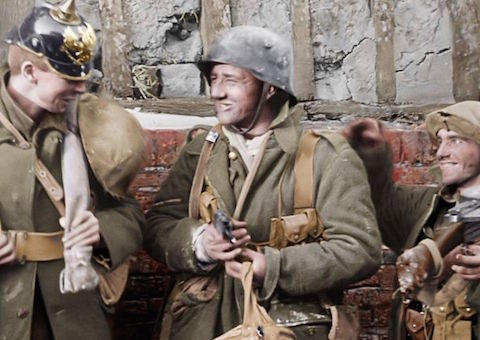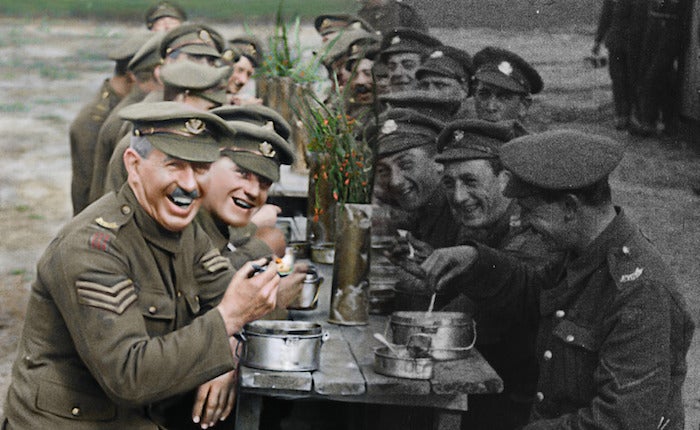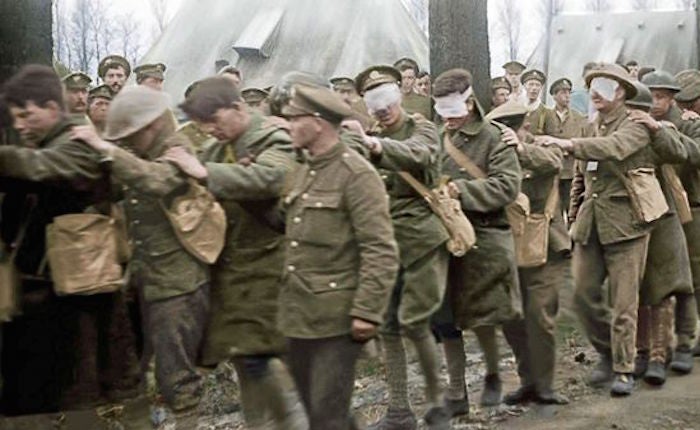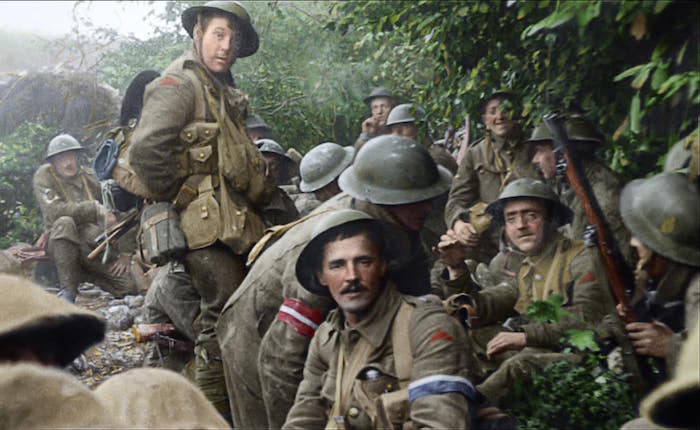
Peter Jackson’s new documentary on the First World War, They Shall Not Grow Old (2018), is an amazing achievement, made possible by new digital technology that turns grainy, black-and-white, silent newsreel footage into a 3-D, color sound film that seemingly takes the viewer into the real world as it existed in 1914-1918. In that sense, it is not a documentary per se, but rather an aesthetic reimagining of what the human experience of the First World War was for ordinary British soldiers at the front in France.
The project began with an invitation from the Imperial War Museum to the director of The Lord of the Rings to look at hundreds and hundreds of hours of war footage preserved at the museum, and to produce a film memorial for the 100th anniversary of the Armistice (November 9, 2018) that would look like no other. Jackson met that challenge by utilizing all the tools of digital film restoration technology, not only to restore, but also to enhance the surviving archival footage. After a brief introduction by Jackson himself, the film opens with black-and-white footage, seen in a square that covers the center of the screen, but does not fill the frame. As Jackson has noted, it was already a huge job to “restore” this footage. First, it was digitized at an extremely high resolution in order to capture every bit of visual information. Hundreds of hours were spent cleaning dirt and scratches from the films and using sharpening tools to focus the image. Another software program was necessary to add frames, so that hand-cranked footage, shot at anywhere from 14 to 18 frames per second, could be adjusted to create natural movement at 24 frames per second. Finally, different software turned the film images into three-dimensional moving shots. The effect on the viewer is as if you are looking through a window into the three-dimensional world of 1914.

But these images are not just silent. Jackson and his Foley artists created realistic recorded sounds of tanks rolling, soldiers marching, horses pulling equipment, guns being loaded and reloaded, canons being fired, often utilizing original ordinance from the war to make the soundscape as real and historically accurate as possible. Meanwhile, we hear the voices of World War I veterans on the soundtrack talk about their experiences, but also seemingly comment on the images. According to Jackson, the sound came from a BBC archive of over 600 hours of interviews with WWI. vets, involving 120 different witnesses, their statements creating a narrative of the war from the point of view of the common soldier. The opening black-and-white sections visualize the initial excitement and sense of adventure experienced by those who enlisted, receiving uniforms and training, then shipping to the front lines. Most shockingly, we learn that many volunteers were significantly under age, and that recruiters, despite regulations to only accept those 19 years old and older, turned a blind eye and signed up even 14 and 15 year olds.

Once we get to the actual trenches in the front lines, the frame opens to fill the screen, while the images themselves turn into full color and 3-D. It is as if we have climbed through the window of history and entered into the real world of 1915. Given the extremely high resolution of the images, Jackson is able to crop long shots to produce stunning close-ups of the faces of these boys and men in uniform. The realism is heightened even further by the fact that Jackson had lip readers analyze what people were saying and then had actors create synchronous sound. The effect is so shocking that at first I thought Jackson had shifted to a fiction film version of the war. But as he has stated, every bit of material processed was found in archives, giving his method a degree of legitimacy and his audience an immediate and visceral experience.

Rather than focusing on a single battle or even naming dates and places, the overall narrative follows the general course of the war on the Western front, as subjectively experienced by actual soldiers: life in the trenches, continuously training or just working to move equipment and supplies when not actually fighting, rest and recreation behind the lines, going “over the top” to attack the enemy during a heavy bombardment, and finally evacuating the dead and wounded after the battle. Images of the aftermath are truly horrific, with corpses seen in full color and 3-D, making this a true anti-war film. Surprisingly, there is no footage of actual combat, so Jackson inserts contemporary magazine illustrations and cartoons to visualize combat. He was forced to this step, because actual combat footage is virtually non-existent, given the fact that cameramen would have had their heads blown off, had they tried to hand-crank a camera in the line of fire, rather than from the relative safety of the trenches.
With the Armistice, Jackson reduces his frame to the opening window and returns to history in black-and-white images, as veterans relate their difficulties in returning to civilian life, especially the fact that no one at home was the least bit interested in their war experiences. It is to Peter Jackson’s credit that 100 years after the fact, we are paying attention to a specific human experience that countless generations of soldiers in all wars have had to face.






 Mobile Navigation
Mobile Navigation

